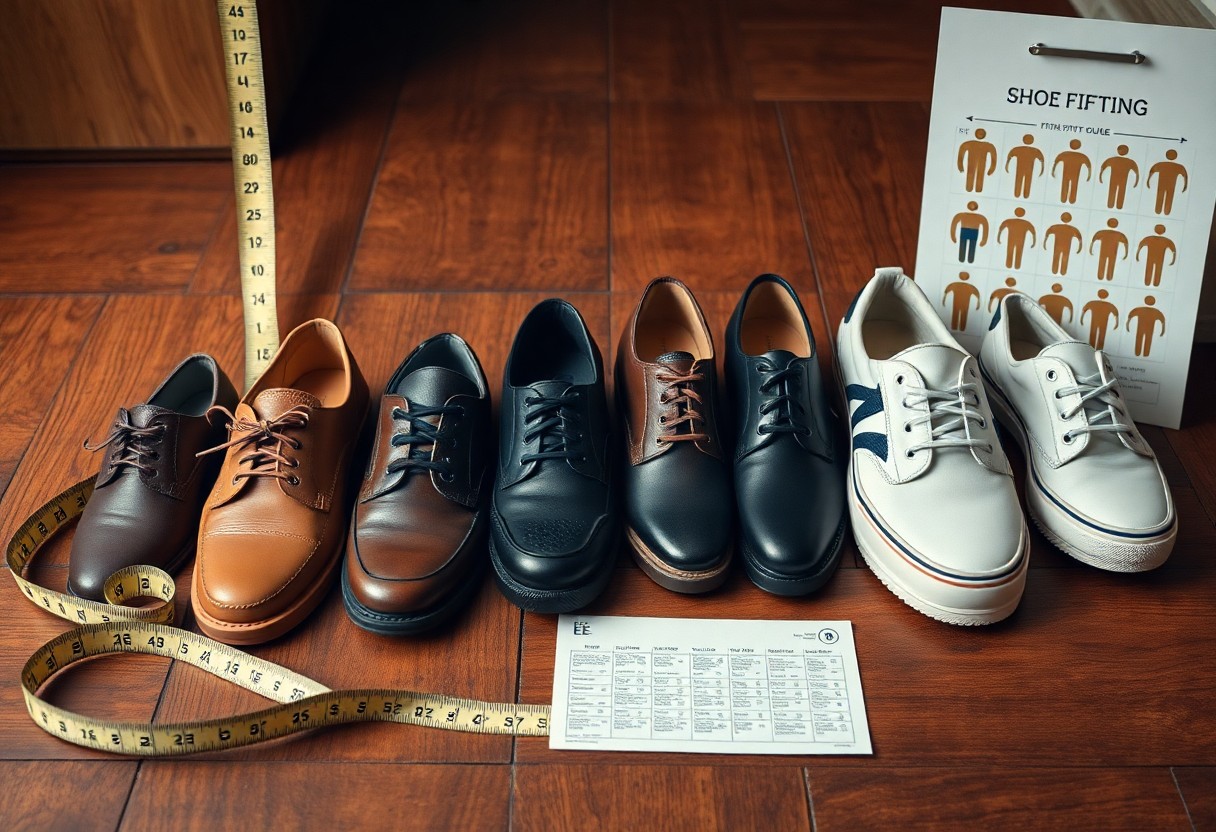
Wearing shoes that do not fit properly in terms of width can result in considerable discomfort and potentially lead to more serious health complications over time. It’s important to understand that shoe sizing includes both length dimensions and width letters, which are essential for ensuring the optimal fit and utmost comfort. The ideal shoe size is based on both these elements, and knowing the width letters—ranging from AA (the narrowest) to EE (the widest)—is vital. These letters are typically found on quality footwear, and being informed about their meanings can help you avoid common fitting mistakes. Regardless of whether your feet are narrow, average, or wide, this detailed guide will support you in interpreting shoe width letters and selecting the perfect fit tailored to your foot shape.
Why Shoe Width Matters for Comfort and Health
Picking the right shoe width is crucial for sustaining foot health and enhancing overall comfort. Your footwear should match not only the length of your feet but also their width to ensure an effective fit. The standardized width classification employs letters ranging from AA to EE, providing specific options designed to accommodate narrow, medium, and wide feet. Having the correct width ensures that your shoes will support your feet adequately, preventing issues like blisters and calluses, while also enhancing your walking experience.
The Development of the Shoe Width Letter System
Nearly a century ago, shoe manufacturers introduced a letter-based width system aimed at assisting customers in discovering better-fitting shoes. This system, which originated in the United States, has developed into the standard measurement approach used by most shoe brands today. The range of letters spans from AA (indicating very narrow) to EE (designating extra wide), offering clarity and guidance for consumers seeking shoes that fit properly.
Understanding How to Measure Width Correctly
One of the most important measurements to assess when fitting shoes is the width at the ball of your foot. To accurately measure this, stand on a flat sheet of paper and mark the widest points of your foot. The distance between these marks, when compared with your foot length, will help identify your specific width letter. It’s essential to focus on these width measurements for achieving the best fit possible.
Your foot width can change by up to half an inch throughout the day, so it’s advisable to take measurements in the afternoon when your feet are at their widest. Consulting a professional fitter can give you an accurate width measurement, typically falling between 3 to 5 inches at the ball of the foot, ensuring you select the most suitable shoes.
How to Interpret Shoe Width Letters for the Best Fit
Shoe width letters form part of a standardized system that ranges from AAAA (4A) to EEEEEE (6E). Gaining an understanding of these letters will significantly assist you in locating shoes that fit perfectly, thereby helping to prevent various foot ailments. The width measurement specifically refers to the broadest area of your foot and may differ between men’s and women’s sizing standards, which is crucial to note when shopping.
Exploring Narrow Width Shoe Selections
When searching for narrow width shoes, it’s important to note that they are labeled as SS (4A), S (3A), or N (2A) for women, and S (2A) or N (B) for men. These sizes are particularly beneficial for individuals whose feet tend to move around inside standard width shoes. A proper narrow fit should provide enough room for your toes to wiggle freely without feeling constrained or overly loose on the sides, ensuring a comfortable wearing experience.
Assessing Medium Width Shoe Options
Medium width categories represent the most commonly available shoe sizes in the marketplace. For women, medium width is typically indicated by ‘M’ or ‘B’, whereas for men, it’s marked as ‘M’ or ‘D’. These standard widths cater to about 80% of the population, making them the preferred choice for many consumers seeking reliable footwear.
Additionally, medium width shoes offer a balanced fit across the ball of your foot. When trying on these shoes, they should feel secure without being restrictive, with roughly 1/2 inch of space between your longest toe and the front of the shoe to ensure optimal comfort and mobility during wear.
Finding Wide Width Shoe Options
For individuals requiring extra space, wide shoe sizes are categorized below the standard widths and are marked as W (D) and WW (EE) for women, while men’s options include W (E/EE) and WW (EEE/EEEE). These sizes are specifically designed to accommodate wider feet or particular foot conditions, providing ample room for comfort and support.
If you need wide shoes, wearing narrow options can lead to significant discomfort. The wide categories allow for additional space in the toe box and across the ball of your foot, enabling your toes to spread naturally without feeling pressure on the sides, thus preventing common foot problems.
Gender Differences in Shoe Width Requirements
Your shoe width needs can vary greatly based on gender. Men’s and women’s shoe width scales utilize distinct letter systems. Although both systems progress from narrow to wide, women’s standard width is ‘B’, while men’s is ‘D’. This distinction reflects the natural differences in foot structure that typically occur between genders, impacting the fit and comfort of footwear.
The Width Measurement Scale for Women’s Shoes
For women seeking the perfect shoe fit, it’s essential to know that the width scale begins at 4A (AAAA, extremely narrow) and extends up to EE (extra wide). The standard medium width is labeled as ‘B’, making it simple to determine if a narrower (A) or wider (C, D) option is necessary. Most women’s footwear is available in B width, with specialized sizes often found in dedicated shoe retailers.
The Width Measurement Scale for Men’s Shoes
The range of width measurements for men’s shoes starts from AA (narrow) and can extend all the way to 6E (extra-extra-wide). The standard medium width in men’s shoes is ‘D’. The most commonly available widths in stores include D (medium) and E (wide), while specialized retailers often provide extended width options for those who need them.
Being aware of the specifics of men’s width scales can greatly enhance your shoe shopping experience. A width increase of one letter corresponds to a 4/16 inch difference in the shoe’s width. Since your feet can change size throughout the day, it’s advisable to measure them in the afternoon when they are at their largest. Each width letter signifies specific measurements: B (narrow) measures 3.4 inches across the ball of the foot, while EE (extra wide) measures 4.4 inches.

Variations in Shoe Sizes Across Different Brands
To achieve your optimal shoe fit, it’s essential to recognize that shoe sizes can vary in both length and width. The width measurement of a shoe is just as crucial as its length for promoting both foot health and comfort. Additionally, your feet can change size throughout the day and may even differ from one another, making it paramount to measure both feet during the shoe selection process to ensure a proper fit.
Differences in Width Measurements by Brand
Width measurements can vary significantly among different shoe brands. A medium width in one brand might feel like a wide width in another. It’s advisable to try on shoes before making a purchase or to consult the specific manufacturer’s size chart when buying online. This discrepancy arises because each company utilizes its own shoe lasts and sizing systems, resulting in differences in fit and comfort across brands.
A Global Overview of Sizing Standards
Shoe width measurement standards differ across various regions and markets. While the US sizing system employs letters (AA to EEE), European manufacturers typically use numerical values (1-8). Japanese width standards use E measurements (2E to 8E), necessitating careful size conversions when purchasing international brands to ensure a proper fit.
Further insights into international sizing standards reveal that width measurements can differ by as much as 1.5 cm between countries. The US system is the most comprehensive, offering six width options for most shoe sizes, while European brands generally provide three width options. Knowing your foot width in millimeters can significantly assist you in determining the right fit across various international sizing systems.

Key Techniques for Accurate Shoe Width Measurement
Unlike traditional shoe sizing, width measurement requires careful attention to both the broadest area of your foot and the shape of your arch. Since your feet naturally expand throughout the day, measuring them in the afternoon will yield the most accurate results, ensuring you select shoes that fit properly and comfortably.
The Advantages of Professional Shoe Fittings
There are numerous benefits to having your feet measured by a shoe fitting expert. Professional measurements guarantee precise width assessment using specialized tools such as a Brannock device. Moreover, you will receive tailored recommendations on specific brands and styles that align with your foot width requirements, helping you make an informed purchasing decision.
Effective Self-Measurement Techniques and Guidelines
To accurately conduct your own measurements, gather these essential tools:
- Blank paper and a pencil
- Measuring tape or ruler
- Well-lit space for clear visibility
- Standing position to ensure accurate dimensions
While obtaining accurate measurements may take some patience, it plays a crucial role in preventing future foot issues and ensuring your comfort.
In addition to basic measurements, consider implementing these detailed guidelines:
- Measure both feet at their widest points to ensure accuracy
- Take measurements while wearing the socks you intend to use with the shoes
- Record your measurements in millimeters for enhanced precision
- Compare your foot measurements to size charts to find the ideal fit
Although self-measurement may not reach the same level of accuracy as professional fittings, it serves as an excellent starting point for your footwear shopping journey, leading to better choices and enhanced comfort.

Identifying Common Shoe Fitting Challenges and Solutions
Wearing shoes with the incorrect width can lead to serious foot issues. As your feet tend to expand throughout the day, they may vary in width by as much as half an inch. Research indicates that 72% of the population wears incorrectly sized shoes, often focusing solely on length while neglecting width measurements, which can result in a range of discomforts and foot problems.
Common Problems Associated with Improper Shoe Width
Wearing shoes that do not fit properly in width can lead to painful blisters, corns, and bunions. If your shoes are too narrow, you might experience numbness and pinching sensations. Conversely, if they are too wide, your feet may slide around, leading to friction injuries and instability while walking. Studies suggest that improper width fittings can increase your risk of falls by as much as 30%, underscoring the importance of proper shoe selection.
Practical Adjustments for Achieving a Better Fit
Across various shoe brands, you will find numerous width options tailored to your specific foot requirements. Always measure your feet at the end of the day when they are at their widest to ensure the most accurate sizing. Professional fitting services can assist you in determining your exact width needs and recommending suitable footwear to enhance your comfort.
In specialty shoe stores, you can discover solutions such as stretching services, different lacing techniques, and width-specific insoles. These adjustments can significantly improve your overall comfort and foot health. Always remember to try on both shoes, as it is common for feet to have slight size discrepancies, and ensuring a proper fit is essential for your daily activities.
Answers to Common Questions about Shoe Width Letters
Q: What do the basic shoe width letters signify in standard sizing?
A: Shoe width letters follow a simple system that ranges from narrow to wide. For women, ‘N’ denotes narrow (2A/AA), ‘M’ indicates medium (B), and ‘W’ stands for wide (D). For men, ‘N’ represents narrow (B), ‘M’ signifies medium (D), and ‘W’ indicates wide (E/EE). These letters guide you in finding the appropriate shoe width for your foot shape, ensuring comfort and support.
Q: How can I determine if I need a different shoe width?
A: There are three primary indicators: 1) If your shoes pinch at the sides, it suggests you need a wider width. 2) If your feet move side-to-side, you likely require a narrower width. 3) If you notice bulging at the sides of your shoes, opt for a wider size. Always measure your feet at the end of the day when they are at their largest for the most accurate width sizing.
Q: What’s the difference between multiple letter widths like ‘EE’ versus ‘E’?
A: Multiple letters indicate increased width. ‘E’ signifies wide, ‘EE’ represents extra wide, and ‘EEE’ denotes triple wide. Each additional letter generally adds about 1/8 inch to the shoe’s width. For narrower sizes, ‘AA’ is narrower than ‘A’. This comprehensive system helps ensure shoes match specific foot widths with enhanced accuracy, contributing to better foot health.
The Article Understanding shoe width letters what they mean and how to choose the right fit appeared first on My Shoes Finder
The Article Shoe Width Letters Explained: Choosing the Perfect Fit Was Found On https://limitsofstrategy.com


You’ve raised such an important point about the relationship between shoe width and overall foot health! I remember struggling with discomfort in my shoes for years until I finally took the time to get properly measured. It was eye-opening to see how much width impacted not just comfort but my posture and how my feet felt after a long day.
You’ve touched on something many people overlook when it comes to footwear. The experience of finally getting measured and discovering the right shoe width can be a real game changer. It’s interesting that something as straightforward as shoe width can have such a ripple effect, not just on comfort but on posture and overall foot health.